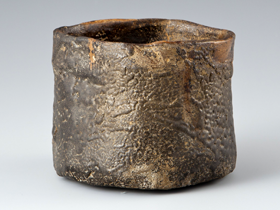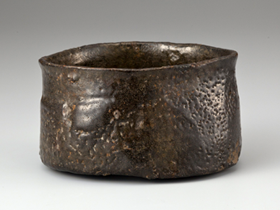美濃桃山陶
Momoyama-period Mino Ware
Back
瀬戸黒
Setoguro
Setoguro
瀬戸黒は真赤に焼けている最中に窯から引き出すので、「引出黒」ともよばれています。色見穴(窯にあけた穴)から焼成中に色見本を取り出し、温度や釉の溶け具合を確認していました。色見を引出した時に黒くなったことから知り得た技術であろうと推測できます。瀬戸黒に類するものは、ほとんどが茶碗です。
鉄釉は、「鬼板」と呼ばれる酸化鉄と木灰をあわせて施釉し、焼成します。窯の温度が1200度程度になった頃合いをみて、鋏で色見穴から引出し、水桶に入れるなど急冷します。急激に冷やされた茶碗は、つやのある漆黒に変化します。
高台は低く身は大ぶりで、裾が角張った半筒形をなし、口縁は稜線のような「山道」をなすものもあり、安土桃山時代の力強さや柔らかさを感じさせます。この器形は、半筒形の志野茶碗にもつながると思われます。
銘「小原女」など優れた作品は、可児市久々利大萱で焼かれたものが多いとされています。
この意匠は、後の織部黒や黒織部に引き継がれていきます。
鉄釉は、「鬼板」と呼ばれる酸化鉄と木灰をあわせて施釉し、焼成します。窯の温度が1200度程度になった頃合いをみて、鋏で色見穴から引出し、水桶に入れるなど急冷します。急激に冷やされた茶碗は、つやのある漆黒に変化します。
高台は低く身は大ぶりで、裾が角張った半筒形をなし、口縁は稜線のような「山道」をなすものもあり、安土桃山時代の力強さや柔らかさを感じさせます。この器形は、半筒形の志野茶碗にもつながると思われます。
銘「小原女」など優れた作品は、可児市久々利大萱で焼かれたものが多いとされています。
この意匠は、後の織部黒や黒織部に引き継がれていきます。
Setoguro works are removed from the kiln mid-firing while they are still red hot and for this reason they are also known as ‘hikidashi-guro’ (pull-out black). It is common to remove samples through small openings in the side of the kiln during a firing to check the temperature, the melting of the glaze etc., and it is believed that is how this technique to produce a jet-black finish was discovered. The majority of works classified as Setoguro are tea bowls.
An iron glaze, consisting of an iron oxide, known as oniita, combined with wood ash is applied before firing. Once the temperature in the kiln reaches approximately 1,200ºC., tongs are used to remove the work through a side opening then it is plunged into water to cool it. This rapid cooling creates a shiny, jet-black finish in the surface of the tea bowl.
These bowls have a cylindrical body with a low foot, bulky form and a square base; the lip can be uneven, producing the image of a ‘mountain path’, and they embody the strength and flexibility of the Azuchi-Momoyama period. It is also thought that this form is linked to the semi-cylindrical Shino ware tea bowls. The tea bowl named ‘Oharame’ is believed to be one of the many works fired at Kukuri Ōgaya in present day Kani City.
This method of decoration was later adopted for Oribe-guro and Kuro-oribe ware.
An iron glaze, consisting of an iron oxide, known as oniita, combined with wood ash is applied before firing. Once the temperature in the kiln reaches approximately 1,200ºC., tongs are used to remove the work through a side opening then it is plunged into water to cool it. This rapid cooling creates a shiny, jet-black finish in the surface of the tea bowl.
These bowls have a cylindrical body with a low foot, bulky form and a square base; the lip can be uneven, producing the image of a ‘mountain path’, and they embody the strength and flexibility of the Azuchi-Momoyama period. It is also thought that this form is linked to the semi-cylindrical Shino ware tea bowls. The tea bowl named ‘Oharame’ is believed to be one of the many works fired at Kukuri Ōgaya in present day Kani City.
This method of decoration was later adopted for Oribe-guro and Kuro-oribe ware.

瀬戸黒茶碗
※荒川豊蔵コレクション
Setoguro tea bowl. ARAKAWA Toyozō Collection

瀬戸黒茶碗
※荒川豊蔵コレクション
Setoguro tea bowl. ARAKAWA Toyozō Collection